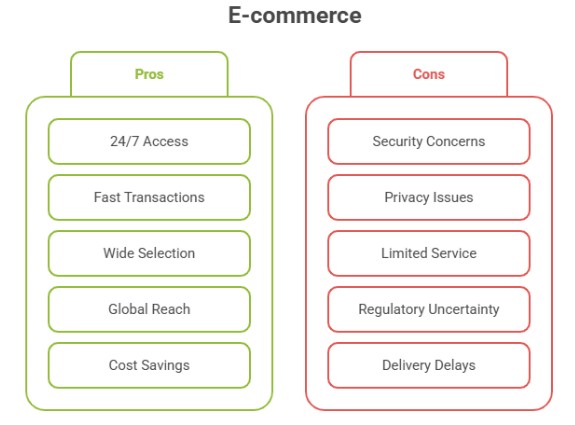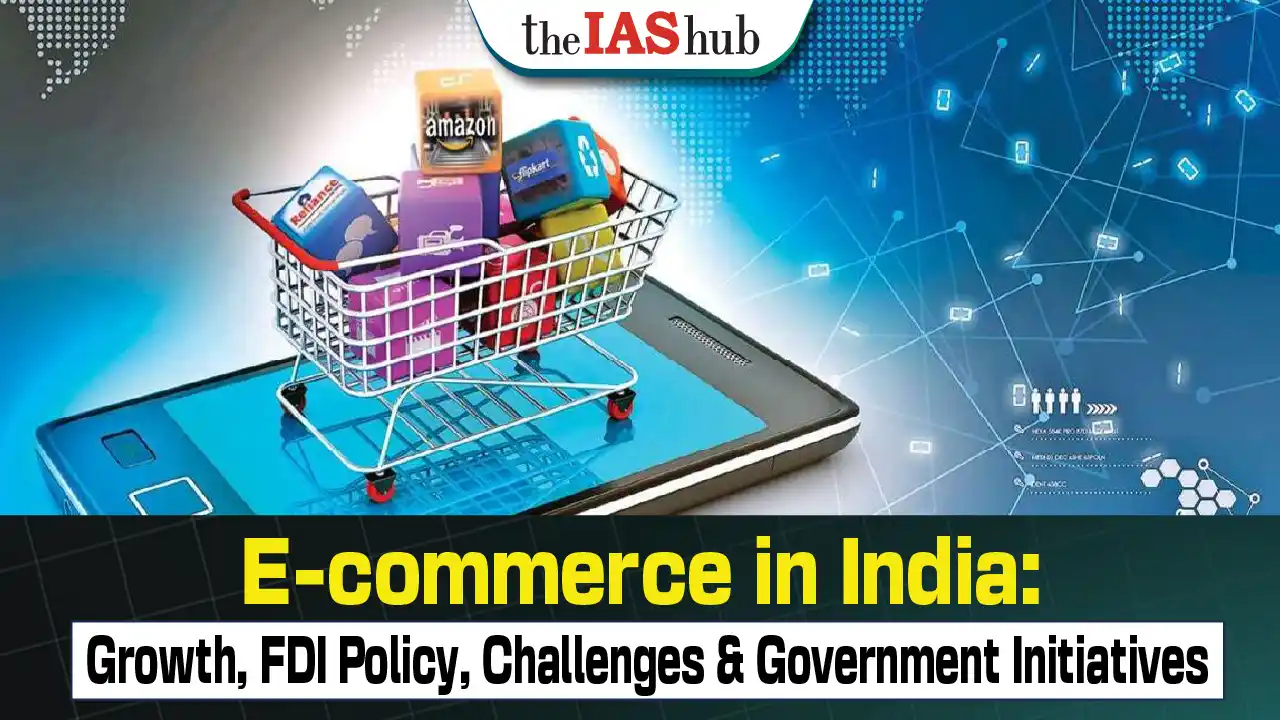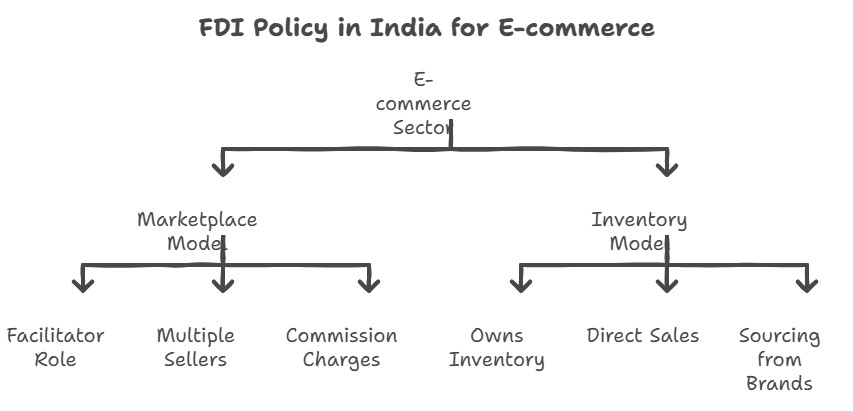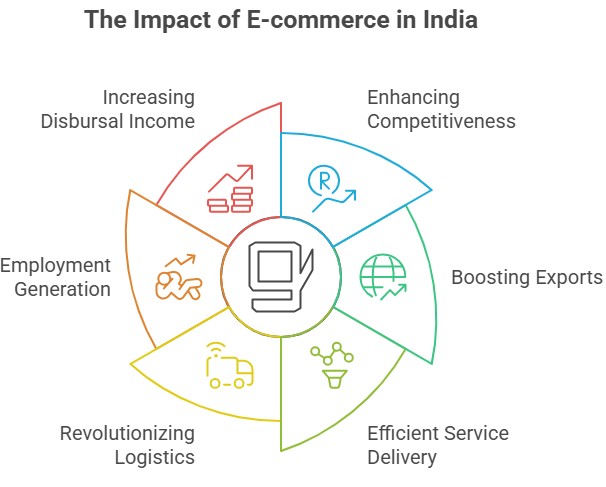E-commerce (electronic commerce) enables businesses and individuals to engage in buying and selling activities as well as the transmission of funds or data, conducted over electronic networks through the Internet.
Driven by the increased adoption of smartphones, the introduction of 4G networks, and the growing affluence of consumers, the Indian e-commerce market is projected to reach a value of US$ 200 billion by 2026, a significant rise from 2017, exhibiting an annual growth rate of 51%, the highest in the world.
The Indian e-commerce industry has been on an upward trajectory and is expected to surpass the United States, becoming the world's second-largest e-commerce market by 2034.
FDI Policy in India for E-commerce
The e-commerce sector in India is classified into two groups based on FDI policy:
- Marketplace Model
- E-commerce entity acts as a facilitator between buyers and sellers on a digital platform.
- Multiple sellers interact with buyers and sell goods.
- Marketplace charges commission from sellers.
- Examples: Naaptol, Shopclues
- Inventory Model
- E-commerce entity owns inventory and sells directly to consumers.
- Sellers are e-commerce companies sourcing from brands and sellers.
- Example: Myntra
E-commerce Industry in India: Status & Facts
- India’s E – Commerce market: Indian e-commerce is expected to grow at a CAGR of 27 per cent, almost three times the overall retail market and expected to surpass the US to become the 2nd largest E-commerce market in the world by 2034.
- Nascent stage – India’s online retail market is just 3% of the total retail market and 25% of organized retail market.
- Greater Adoption - India has the third largest online shopper base of 150 million (2021) after China and US and is expected to reach 350 million by 2026.
- Huge Employment potential – Directly & indirectly through backward linkages (MSME, Textile, Leather, Farmers, craftsmen etc) & forward linkages (Logistics, packaging, transport, storage, advertising etc.)
- Sunrise sector - Fashion, grocery, general merchandise sector would capture nearly two-thirds of the Indian e-commerce market by 2027.
Significance of E-commerce in India
- Enhancing Competitiveness of Indian Goods
- Boosting Exports
- Efficient Service Delivery
- Revolutionizing Logistics
- Employment Generation
- Increasing Disbursal Income for Low-Income Households
Regulatory Framework for E-commerce in India
- Business Regulation
- Foreign Direct Investment (FDI) policy and Foreign Exchange Management Act (FEMA) govern foreign investments and business setups in India's B2B e-commerce sector.
- Market and inventory-based models in India must adhere to specific rules outlined in the FDI policy.
- Other regulations governing e-commerce in India include the Companies Act, Payment and Settlement Act, RBI regulations on payment mechanisms, labelling and packaging rules, and more.
- Taxation Related
- Income Tax Act, 1961
- Double Taxation Avoidance Agreement
- Goods and Services Tax (GST)
- Legal Issues
- Indian Copyright Act, 1957: Copyright protection is provided to original creative works shared or sold through e-commerce platforms.
- The Patents Act, 1970: Regulations under this act govern the protection and enforcement of patents related to e-commerce innovations.
- Labor laws: E-commerce platforms must comply with labour laws concerning employment practices, working conditions, and employee benefits.
- Data and Associated Issues
- Information Technology Act, 2000 (IT Act): The IT Act regulates various aspects of e-commerce, including electronic contracts, digital signatures, and cybercrime.
- Section 84A and Section 43A: These sections of the IT Act specifically address the obligations of entities dealing with sensitive personal data or information.
- The Information Technology (Reasonable security practices and procedures and sensitive personal data or information) Rules, 2011: These rules provide guidelines for the protection of sensitive personal data and information collected and stored by e-commerce platforms.
- The Information Technology (Guidelines for Intermediaries and Digital Media Ethics Code) Rules, 2021: Recently introduced rules focus on regulating digital media intermediaries, including e-commerce platforms.
- Consumer Protection Act, 2019, and Consumer Protection (E-Commerce) Rules, 2020: These regulations aim to safeguard the interests of consumers in e-commerce transactions V. Benefits of E-commerce
Benefits of E-commerce
- Availability and flexibility: E-commerce sites are accessible 24/7, allowing customers to shop at their convenience without any time restrictions.
- Speed of access: Physical stores often face overcrowding, leading to slower purchasing activities.
- Wide range of options: Range of products can be accessed at single application. Ex. Flipkart, Amazon
- No geographical barrier: Delivery of products are being taken place in the remotest part of the country.
- Lower cost: Due to decrease in miscellaneous expenses and increase in economy of scale, cost of the products also gets reduced.
- Personalization and product recommendation: Feedback, remarks system prove an idea to customers to know about the products in a better way.
- For business: Advantages include an expanded customer base, increased sales, extended business reach, and the convenience of recurring payments and instant transactions.
Limitations of E-commerce
- Lack of Security: Inadequate security measures in online transactions instil fear and apprehension among users.
- Lack of Privacy: The absence of robust encryption methods to safeguard personal data, identity, and financial transactions hinders widespread acceptance of e-commerce shopping habits.
- Limited Customer Service: Resolving complaints and assessing product suitability is more straightforward in physical stores compared to e-commerce sites.
- Regulatory Issues: Ambiguity surrounding cyber laws regulating online purchases fosters mistrust between buyers and consumers.
- Limited Knowledge about Product Suitability: Online purchases lack the advantage of physically experiencing products, relying solely on electronic images. Discrepancies may arise between the delivered product and the electronic images displayed, leading to unfulfilled buyer expectations.
- Wait Period in Product Delivery: Unlike physical stores where customers can purchase and take products home instantly, online shoppers must wait for delivery. Although shipping times have improved with next-day and even same-day delivery, instantaneous fulfilment is not yet achievable.

Government Initiatives Boosting E-commerce Sector in India
Digital India, Make in India, Start-up India, Skill India, and Innovation Fund
- These schemes were launched to provide a significant impetus to the e-commerce sector.
- They aim to foster digital transformation, encourage domestic manufacturing, support startups, promote skill development, and provide funding for innovation.
Policy Support
- B2B e-commerce allows 100% FDI.
- Marketplace model of e-commerce permits 100% FDI under the automatic route.
- Clarity in FDI policy definitions related to e-commerce, e-commerce entities, marketplace-based model, and inventory-based model is a positive step.
Digital India Initiatives
- Under the Digital India movement, several initiatives such as Umang, Start-up India Portal, and Bharat Interface for Money (BHIM) were launched to drive digitization and enhance digital accessibility.
Encouraging Domestic Participation
- The equalization levy rules of 2016 were amended to promote domestic participation.
- Foreign companies operating e-commerce platforms in India are required to have Permanent Account Numbers (PAN).
Consumer Protection (E-commerce) Rules, 2020
- Ban on Flash Sale: The draft rules seek to ban “specific flash sales” by e-commerce entities.
- Fall-back Liability: The rules have also introduced the concept of “fall-back liability”, which says that e-commerce firms will be held liable in case a seller on their platform fails to deliver goods or services due to negligent conduct, which causes loss to the customer.
- Restricting Manipulation: The rules also propose to restrict e-commerce companies from “manipulating search results or search indexes”.
- Consumer Consent: E-commerce companies will also be restricted from making available to any person information pertaining to the consumer without express and affirmative consent.
- Provide Domestic Alternatives: Further, the companies will have to provide domestic alternatives to imported goods, adding to the government’s push for made-in-India products.
- National Consumer Helpline: The draft amendment also proposes to ask e-commerce firms to mandatorily become a part of the National Consumer Helpline.
- Mandatory Registration: Any online retailer will first have to register itself with the Department of Promotion for Industry and Internal Trade (DPIIT).
- No Differential Treatment: The rules propose mandating that no logistics service provider of a marketplace e-commerce entity shall provide differentiated treatment between sellers of the same category.
- Associated Enterprise: Any entity having 10 percent or more common ultimate beneficial ownership will be considered an “associated enterprise” of an e-commerce platform.
- Time-bound Information: The draft rules propose that the information sought by the government agency will have to be produced by the e-commerce company “within 72 hours of the receipt of an order from the said authority”.
- Open Network for Digital Commerce (ONDC):
- Launched by the Department for Promotion of Industry and Internal Trade (DPIIT) under the Ministry of Commerce and Industry.
- Investment in Fiber Network for 5G:
- The Government is heavily investing in rolling out a fibre network for 5G technology, which will contribute to the growth of e-commerce in India.
Challenges in the E-commerce Sector
- Consumer Vulnerability, Dynamic Pricing and Regulatory Models, Impact on Banks, Balancing Innovation and Protectionism, Policy Challenges
Way Forward
- Risk-Based Regulations: There is a need for a risk-based regulatory framework to address emerging challenges in e-commerce.
- Strengthen Competition Commission of India (CCI): Efforts should be made to enhance the capacity of the Competition Commission of India to effectively regulate the e-commerce sector.
- Nurturing Start-ups and SMEs: The government must create an enabling ecosystem that nurtures online start-ups and small and medium enterprises (SMEs).
- Focus on Infrastructure: The government should prioritize the development of data centers and cloud infrastructure to support the growth of the e-commerce sector.
- Consumer Protection: Strengthening consumer protection measures is crucial to instill trust and confidence in the e-commerce ecosystem.
Conclusion
E-commerce in India is experiencing remarkable growth and is poised to become the world's second-largest market by 2034. It encompasses various types of transactions, driving competitiveness, boosting exports, and revolutionizing logistics. However, challenges such as security concerns, limited customer service, and regulatory issues need to be addressed.














